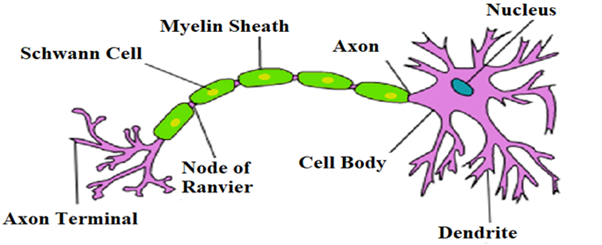Answer
396.9k+ views
Hint: The body has regeneration capability in order to heal the damaged tissues but not all parts of the body can regenerate. The cells in our body that do not have regeneration capacity play a vital role in the control and coordination of the body.
Complete answer:
The cells that are least likely to be replaced by new cells are neurons because they do not have centrioles which are essential for cell division. The function of centrioles is the formation of spindle fibers which cause the movement of chromosomes. Without centrioles, the chromosomes won’t move to the poles and thus division cannot take place. The neurons are the structural and functional unit of the nervous system of the body and thus are highly specialized for the conduction of impulses. During this process of specialization, they lose their centrioles and thus the regeneration ability. The liver cells, cells of the Malpighian layer as well as osteocytes (bone cells) all are capable of dividing and can replace lost cells.
Additional Information: Liver cells: Hepatocytes are the cells that make up 80% of the liver’s mass and they are involved in the synthesis and storage of proteins, the transformation of carbohydrates, synthesis of cholesterol, bile salts, phospholipids, detoxification, etc.
The malpighian layer of the skin: The skin is the largest organ of the body involved in the protection of the body along with insulation, temperature regulation, etc. The skin is divided into an outer waterproof epidermis and an inner dermis. The epidermis is further divided into an outer layer of keratinized cells and an inner Malpighian layer of non-keratinized cells.
Osteocytes: Osteocytes are cells that lie inside the calcified matrix of the bone and are responsible for maintaining mechanical strain and homeostasis inside the bone.
So, the correct option is ‘Neurons’.
Note: -A typical neuron is made up of three parts known as the cell body, dendrites, and axon.
-The dendrites are responsible for conducting a nerve impulse towards the cell body whereas the axon is responsible for conducting it away.
-The axon terminates into bulb-like structures known as the synaptic knobs which are associated with the dendrites of the next neuron to pass the impulse forward.

Complete answer:
The cells that are least likely to be replaced by new cells are neurons because they do not have centrioles which are essential for cell division. The function of centrioles is the formation of spindle fibers which cause the movement of chromosomes. Without centrioles, the chromosomes won’t move to the poles and thus division cannot take place. The neurons are the structural and functional unit of the nervous system of the body and thus are highly specialized for the conduction of impulses. During this process of specialization, they lose their centrioles and thus the regeneration ability. The liver cells, cells of the Malpighian layer as well as osteocytes (bone cells) all are capable of dividing and can replace lost cells.
Additional Information: Liver cells: Hepatocytes are the cells that make up 80% of the liver’s mass and they are involved in the synthesis and storage of proteins, the transformation of carbohydrates, synthesis of cholesterol, bile salts, phospholipids, detoxification, etc.
The malpighian layer of the skin: The skin is the largest organ of the body involved in the protection of the body along with insulation, temperature regulation, etc. The skin is divided into an outer waterproof epidermis and an inner dermis. The epidermis is further divided into an outer layer of keratinized cells and an inner Malpighian layer of non-keratinized cells.
Osteocytes: Osteocytes are cells that lie inside the calcified matrix of the bone and are responsible for maintaining mechanical strain and homeostasis inside the bone.
So, the correct option is ‘Neurons’.
Note: -A typical neuron is made up of three parts known as the cell body, dendrites, and axon.
-The dendrites are responsible for conducting a nerve impulse towards the cell body whereas the axon is responsible for conducting it away.
-The axon terminates into bulb-like structures known as the synaptic knobs which are associated with the dendrites of the next neuron to pass the impulse forward.

Recently Updated Pages
How many sigma and pi bonds are present in HCequiv class 11 chemistry CBSE

Why Are Noble Gases NonReactive class 11 chemistry CBSE

Let X and Y be the sets of all positive divisors of class 11 maths CBSE

Let x and y be 2 real numbers which satisfy the equations class 11 maths CBSE

Let x 4log 2sqrt 9k 1 + 7 and y dfrac132log 2sqrt5 class 11 maths CBSE

Let x22ax+b20 and x22bx+a20 be two equations Then the class 11 maths CBSE

Trending doubts
Fill the blanks with the suitable prepositions 1 The class 9 english CBSE

At which age domestication of animals started A Neolithic class 11 social science CBSE

Which are the Top 10 Largest Countries of the World?

Give 10 examples for herbs , shrubs , climbers , creepers

Difference between Prokaryotic cell and Eukaryotic class 11 biology CBSE

Difference Between Plant Cell and Animal Cell

Write a letter to the principal requesting him to grant class 10 english CBSE

Change the following sentences into negative and interrogative class 10 english CBSE

Fill in the blanks A 1 lakh ten thousand B 1 million class 9 maths CBSE



